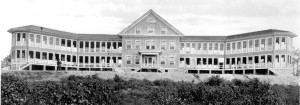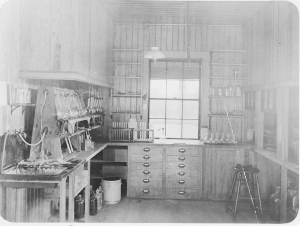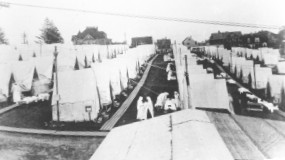
Then Massachusetts Commissioner of Public Health, Dr. Howard Koh, officially opened the exhibit at 6:00pm on May 25, 2001 at the Heritage State Park in Lawrence where it remained until August 31, 2001. The exhibit featured a number of the important developments in the history of public health in Lawrence and Massachusetts including:
-
The development and impact of the Lawrence Experiment Station in 1893 It became a world-renowned center of research on water filtration and had an immediate and profound effect on the health of Lawrencians. The overall mortality rate for the city dropped by 21% in the first year after the filtration system began.
 Interior of Experiment Station started by Hiram Mills
Interior of Experiment Station started by Hiram Mills
-
A chronology of the events surrounding the legendary influenza outbreak of 1918 The exhibit documented the events in the city and state during the worldwide outbreak that resulted in the largest number of deaths in the history of Lawrence. Over 2000 Lawrencians died in 1918 (compared to 1391 in 1917 and 1280 in 1919) and the exhibit describes the steps taken to combat this mysterious and deadly epidemic. Included are pictures of the Tent City that was established to quarantine the victims.
 Tent City, Influenza Epidemic 1918
Tent City, Influenza Epidemic 1918
- Results from the The Report of the Lawrence Survey, 1912 (The White Fund) One tool of public health reformers was the local study documenting living conditions in a community. A classic example was The Lawrence Survey. Funded by the White Fund, it meticulously documented overcrowded housing conditions, identified patterns of disease in different wards of the city, made specific recommendations for improving the milk supply and outlined a plan for the organization of the Lawrence Health Department.
- Maps documenting the evolution of public health efforts in the city One map describes the effort to straighten the Spicket River to improve sanitation, with the unintended side effect of increasing the likelihood of flooding. An 1889 map also details the spread of diphtheria in the city.
- Advertisements and posters for patent medicines (e.g. Lydia Pinkham’s) and from public health officials.
- Timeline from 1850 to 1950 Identified the major events in the history of public health in Lawrence, Massachusetts and the US.
The exhibit was funded in part through the Lawrence Cultural Council and the Massachusetts Cultural Council. It has been developed by the Lawrence History Center: Immigrant City Archives and Museum in collaboration with: • Lawrence Heritage State Park • Lawrence Experiment Station • Boston University School of Public Health • Merrimack College Urban Resource Institute • Public Health Museum, Tewksbury, MA